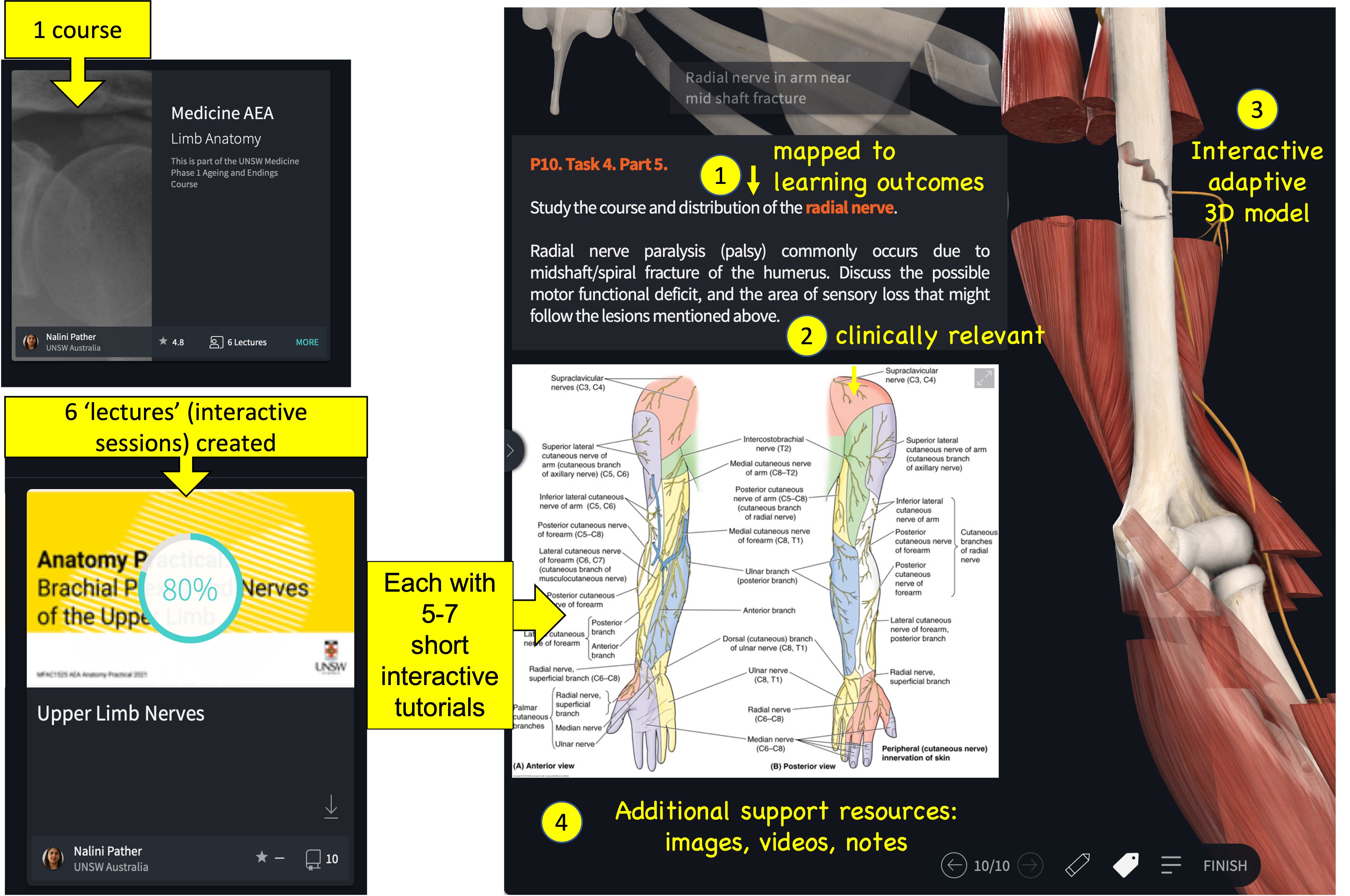Integrating VR using Complete Anatomy and optimising its usefulness by promoting student advocacy
Complete Anatomy is platform of 3D Anatomy models. In 2021 TP4, M&H Faculty made a subscription of the Complete Anatomy (CA) platform available to the discipline of Anatomy. From my experience of technology-enhanced learning, I realised that for this resource to be impactful, it had to be integrated into the course learning activities and not available only as an adjunct tool or for student self-directed learning.
The platform availability coincided with the first week of AEB 2021, the course I lead in Phase I Medicine. I therefore used the opportunity firstly, to fully integrate the virtual models available through the CA platform into the anatomy practical sessions, and secondly to provide an example to the discipline academic team on how this platform could be integrated into course learning activities. This included (see figure below):
- creating a Complete Anatomy Course which collates the CA models relevant for a course in the platform,
- designing six ‘lectures’ to essentially scaffold the student through the 3D models relevant to each topic, and
- enhancing the topic 'lecture' workflow through 5-7 specific tasks that annotated and augmented the models - customising it for the student's learning outcomes.
Each of the ‘lectures’ was designed to be in an integrated set of 5-7 tasks to support an anatomy practical session. A task (see figure below) was:
- mapped to the practical learning outcomes
- integrated clinically relevant content
- incorporated the use of an adapted 3D model
- included a worksheet with embedded videos and resources, as well as notes.
- Aligned with a PowerPoint that included relevant cadaveric dissection images and cadaveric 3D VR model
Enabling student advocacy to optimise the integration of CA into Anatomy teaching:
The CA course and ‘lectures’ were available for students to interact as they needed to develop competency. In addition, students were given opportunity to provide feedback in terms of how the integration was supporting their learning. Student advocacy enable the integration into practicals to be optimised. For example, mid-way through the course, students reported that preferred to use half the practical time for the CA activity (as they could revisit this in their own time) and the other half of the time on the cadaveric images and 3D VR models. This feedback was immediately acted on and the practical session format changed accordingly.
Student feedback on Complete Anatomy was overwhelmingly positive:
Unsolicited emails:
- THANK YOU for adding me to the AEA course for Complete Anatomy. It is really helpful to have the practical worksheet activities linked to a specific model and to know which learning outcomes I need to focus on. THANK YOU for everything.
- Thank you for organising such a great week 1 of AEA! All the students are super appreciative of your efforts :) especially the AEA group on Complete Anatomy.
- Thank you for everything this term – everything you did was amazing especially listening to our needs. I wanted to say thank you especially for all the additional resources and for your drop in tutorials… also for Complete Anatomy. BTW, my sister uses Complete Anatomy in her degree at …>>>. and says it was not used anywhere as well as in our course. She is going to show her anatomy lecturer
myExperience Comments:
- With the AEA course having a heavy amount of testing on Anatomy, the use of Complete Anatomy was a great addition…. The practical sessions have also been a lot more interactive to aid in learning about Anatomy.
- Complete anatomy was great!! especially when supplemented with slides during anatomy pracs
- The best thing was the amount of support that I felt throughout. Things like the padlet and periodical updates/check–ins made me feel more connected to a community despite online learning. There were also lots of amazing resources provided, including complete anatomy, extra lecture/practical notes, and extra tutorials and online modules.





